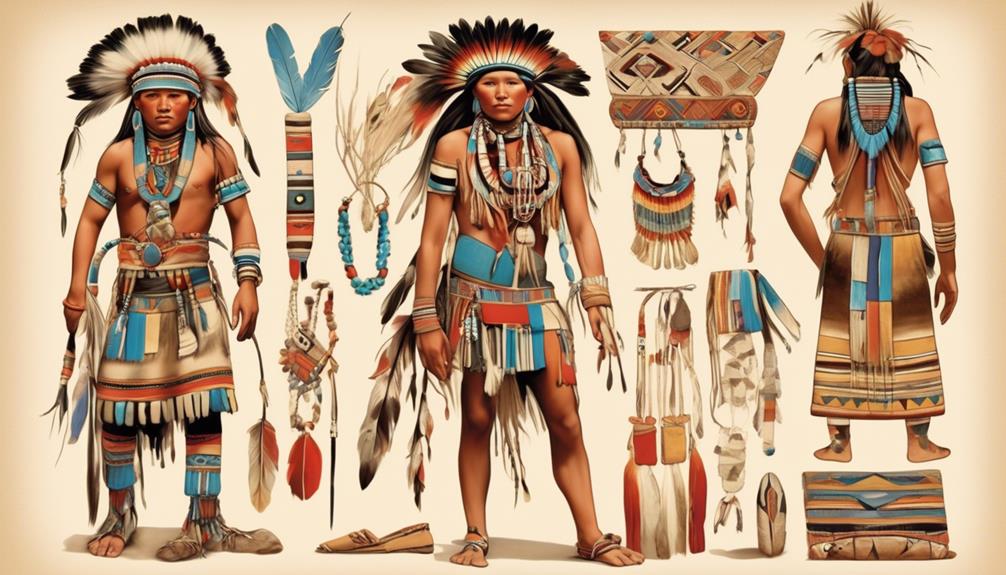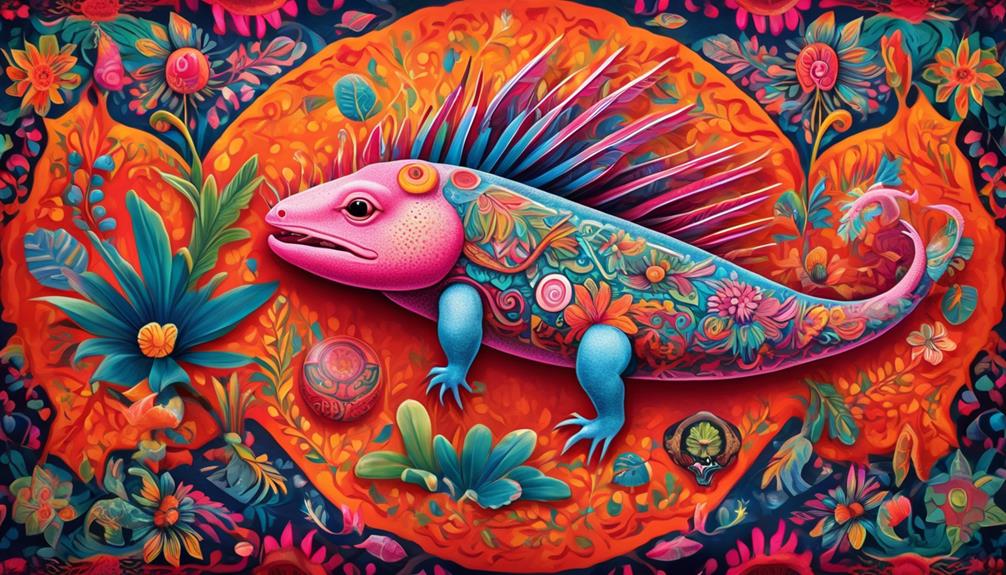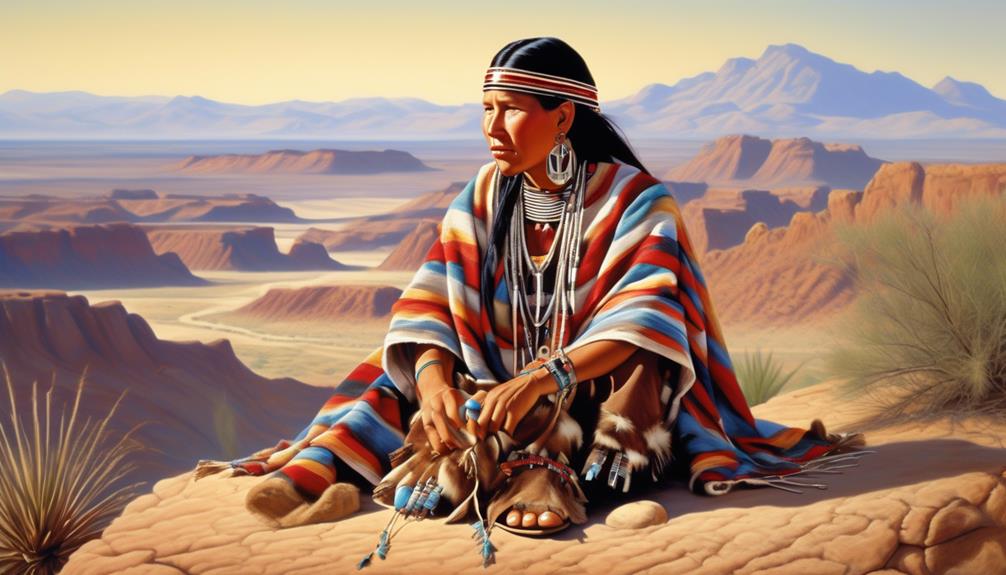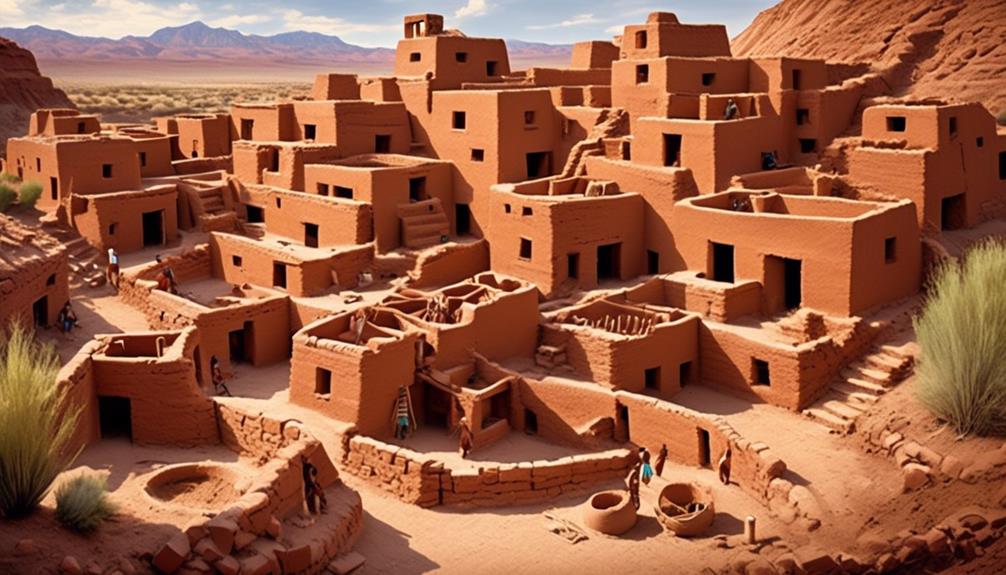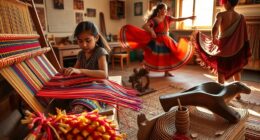As the famous saying goes, “clothes make the man.” Delving into the history and culture of the Hopi tribe showcases the significance and distinctive style of their traditional attire.
The clothing of the Hopi people is rich with symbolism, reflecting their deep connection to their land, traditions, and spirituality. From ceremonial regalia to everyday garments, each piece of clothing tells a story and holds a special meaning within the tribe.
Join us on a journey to uncover the secrets woven into the fabric of the Hopi tribe's attire, revealing the intricate artistry and cultural significance that continue to captivate curious minds.
Key Takeaways
- Traditional Hopi clothing for ceremonies is intricately woven and reflects Hopi values and beliefs, with vibrant colors and intricate patterns.
- Everyday attire of the Hopi people is simple and functional, with cotton dresses for women and cotton shirts and pants for men, adorned with intricate geometric patterns.
- Hopi clothing designs incorporate symbols representing elements of nature, spiritual beliefs, and ceremonies, connecting the Hopi people to the natural world and ancestral traditions.
- Hopi garments are made using materials such as cotton, yucca, and animal fibers, with natural dyeing techniques and skilled craftsmanship, serving practical purposes with cultural and spiritual significance.
Traditional Hopi Clothing for Ceremonies
Traditional Hopi clothing for ceremonies consists of intricately woven garments and symbolic accessories that hold deep cultural and spiritual significance. Ceremonial attire is a crucial aspect of Hopi tradition, reflecting the tribe's values and beliefs. The traditional regalia worn during ceremonies is meticulously crafted by skilled artisans, using techniques that have been passed down through generations.
Each piece of clothing and accessory is rich in symbolism, representing the interconnectedness of the Hopi people with their land, history, and spiritual beliefs.
The ceremonial attire worn by the Hopi tribe is characterized by vibrant colors and intricate patterns, each carrying its own unique meaning. The garments are often adorned with symbols that convey stories of creation, migration, and the spiritual teachings of the Hopi.
Traditional regalia isn't only a form of dress but also a representation of the tribe's cultural identity and values. Through the wearing of these garments, the Hopi people honor their ancestors and express their continued dedication to preserving their heritage.
Everyday Attire of the Hopi People
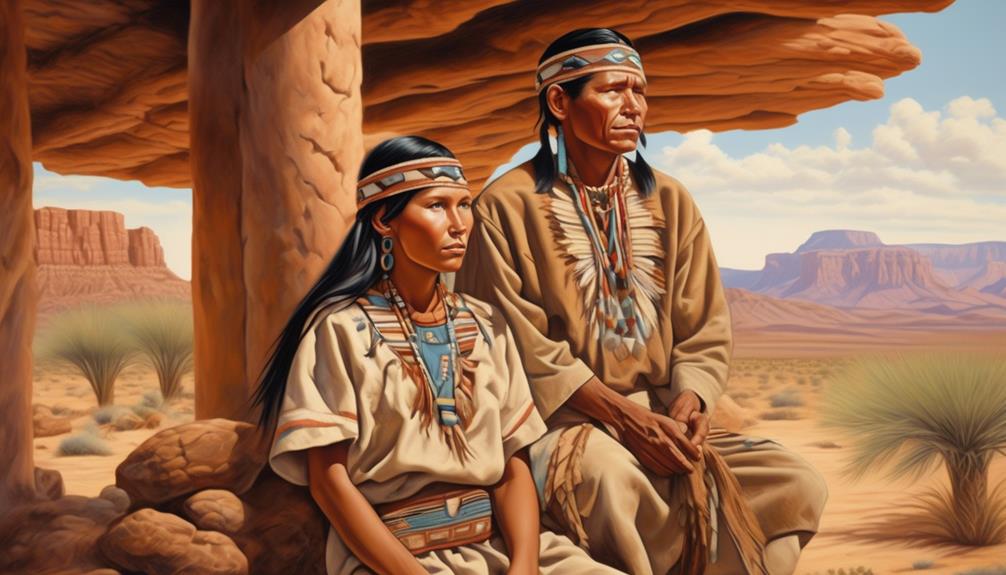
The vibrant and symbolic ceremonial attire of the Hopi people contrasts with the practical and utilitarian everyday clothing worn for regular activities. Hopi clothing for daily wear is primarily characterized by its simplicity and functionality. Traditional attire for daily activities includes cotton dresses for women and cotton shirts and pants for men, often adorned with intricate geometric patterns. The clothing symbolism in everyday wear is more subdued compared to ceremonial dress, reflecting the practical nature of these garments. Garment materials for daily wear are typically chosen for their durability and comfort, with cotton being the primary fabric used. Clothing techniques such as weaving and embroidery are employed to create sturdy and long-lasting everyday attire. The clothing evolution has seen the integration of modern materials and styles, while still holding onto traditional designs and patterns.
| Garment Materials | Clothing Techniques | Clothing Evolution |
|---|---|---|
| Cotton | Weaving | Integration of modern materials |
| Wool | Embroidery | Preservation of traditional designs |
| Leather | Beadwork | Adaptation to contemporary styles |
Symbolism in Hopi Clothing Designs
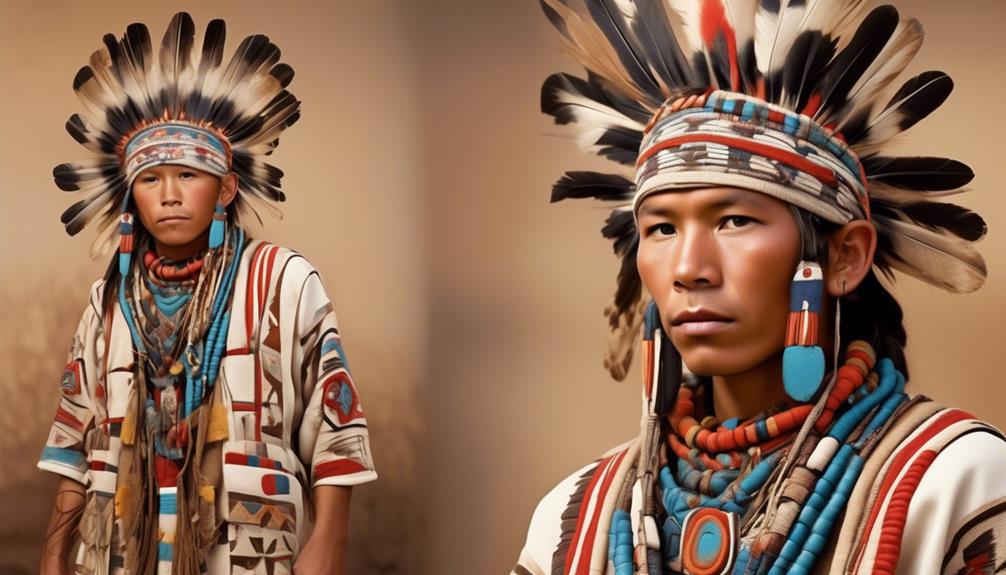
Symbolism permeates the intricate designs of Hopi clothing, reflecting the tribe's rich cultural heritage and spiritual beliefs. The clothing designs hold deep cultural significance and are often imbued with symbolism that conveys the Hopi people's connection to the natural world, their religious practices, and their ancestral traditions.
- Nature: Many Hopi clothing designs feature symbols representing elements of nature, such as clouds, rain, and animals, which hold profound spiritual meaning for the tribe. These symbols serve as a reminder of the interconnectedness between the Hopi people and the natural world.
- Spiritual Beliefs: The intricate patterns found in Hopi clothing often depict symbols related to the tribe's spiritual beliefs and ceremonies. These symbols not only adorn the clothing but also serve as a form of spiritual protection and guidance for the wearer.
- Ancestral Traditions: The designs on Hopi clothing often incorporate symbols that have been passed down through generations, representing the enduring legacy of the tribe's ancestral traditions. These symbols serve as a visual link to the tribe's history and collective identity.
Materials and Techniques in Hopi Garments

In exploring the intricate world of Hopi clothing, our attention shifts to the materials and techniques that form the foundation of these culturally significant garments. The Hopi people were skilled in textile production, using a variety of materials such as cotton, yucca, and animal fibers to create their garments. Cotton was cultivated and spun into thread, while yucca fibers were used for weaving and creating sturdy fabrics. The garments were often dyed using natural materials such as plants, berries, and mineral pigments, showcasing the Hopi's intricate dyeing techniques. The resulting colors held deep symbolic meanings within the Hopi culture, adding another layer of significance to their clothing.
The following table provides a glimpse into the materials and dyeing techniques utilized by the Hopi tribe:
| Materials | Dyeing Techniques |
|---|---|
| Cotton | Plant-based dyes |
| Yucca fibers | Berry dyes |
| Animal fibers | Mineral pigments |
| Natural pigments | Symbolic color meanings |
The Hopi tribe's mastery of textile production and dyeing techniques allowed them to create garments that not only served practical purposes but also held deep cultural and spiritual significance.
Evolution of Hopi Clothing Styles
Having evolved over centuries, Hopi clothing styles reflect the tribe's rich cultural heritage and the influence of changing societal dynamics. The evolution of Hopi clothing styles has been shaped by a variety of cultural and historical influences, resulting in a diverse and symbolic array of garments that hold deep cultural significance for the Hopi people.
- Cultural Significance
Hopi clothing styles hold immense cultural significance, serving as a visual representation of the tribe's traditions, values, and spiritual beliefs. Each garment is intricately tied to specific ceremonies, rituals, and social events within the Hopi community, emphasizing the importance of clothing as a means of cultural expression and identity.
- Historical Influences
The evolution of Hopi clothing styles has been influenced by historical events, interactions with neighboring tribes, and the introduction of new materials and techniques through trade and colonization. As a result, Hopi garments have undergone significant transformations, adapting to the changing socio-political landscape while retaining their cultural integrity.
- Adaptation and Innovation
Over time, Hopi clothing styles have adapted to meet the practical needs of the community while also incorporating innovative design elements. This adaptability reflects the tribe's ability to preserve traditional techniques while embracing new materials and styles, showcasing the dynamic nature of Hopi fashion throughout history.
Frequently Asked Questions
How Did the Hopi Tribe Adapt Their Clothing for Different Weather Conditions?
We adapted materials and designs for weather protection, reflecting our cultural significance.
Clothing varied based on season and climate. In colder weather, we wore layers of woven cotton and animal hides for warmth. During hot seasons, we utilized lightweight fabrics and loose-fitting garments to stay cool.
Our traditional designs incorporated symbols and patterns representing our connection to nature and the spiritual world, showcasing our unique identity and heritage.
What Role Did Color Play in Traditional Hopi Clothing Designs?
Color played a significant role in traditional Hopi clothing designs. Symbolism was deeply ingrained in the choice of colors, with each hue holding specific meanings and cultural significance.
Traditional weaving techniques were employed to incorporate these symbolic colors into garments, creating a visual language that communicated stories, beliefs, and social status.
This intricate use of color and weaving techniques reflected the rich cultural heritage and values of the Hopi tribe.
Did the Hopi Tribe Have Specific Clothing for Different Age Groups or Social Classes?
Yes, the Hopi tribe had specific clothing for different age groups and social classes.
Customary attire varied by gender and ceremonial role, reflecting the tribe's cultural significance.
For instance, unmarried Hopi girls wore a traditional dress called a mantas, while Hopi men wore kilts and sashes.
Social classes were distinguished through the quality of materials and craftsmanship used in their clothing, emphasizing the importance of status within the community.
Were There Any Specific Rituals or Ceremonies Associated With the Creation or Wearing of Hopi Clothing?
In the creation rituals of the Hopi Tribe, ceremonial clothing holds a special significance. This attire, adorned with traditional designs, serves as a testament to the tribe's deep-rooted cultural heritage.
Through meticulous craftsmanship, the clothing reflects the tribe's climate adaptation and spiritual connection to the land. These garments aren't merely fabric and thread; they embody the essence of the tribe's rituals and ceremonies, symbolizing the interconnectedness of the Hopi people with their traditions.
How Did Contact With European Settlers and Traders Impact the Evolution of Hopi Clothing Styles?
Contact with European settlers and traders impacted the evolution of Hopi clothing styles through cultural exchange and trade. This led to clothing adaptations influenced by European fabrics and styles.
Weather considerations affected the use of materials, and color symbolism may have been impacted by exposure to new dyes.
Age and social distinctions within the tribe likely continued to influence clothing choices, as did the preservation of traditional rituals and ceremonies.
Conclusion
In conclusion, the traditional clothing of the Hopi tribe is a beautiful representation of their cultural heritage and beliefs.
Did you know that nearly 90% of Hopi clothing is still handmade using traditional materials and techniques?
This statistic highlights the importance of preserving their unique and intricate clothing traditions for future generations to appreciate and admire.
Mary is a passionate writer who brings creativity and a fresh perspective to our team. Her words have the power to captivate and inspire, making her an essential contributor to our content. Mary’s commitment to storytelling and dedication to promoting Indigenous culture ensures that her work touches the hearts of our readers. We’re fortunate to have her as part of our team.
